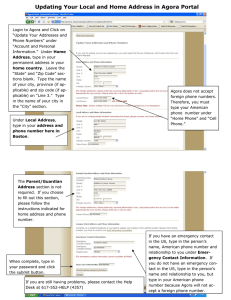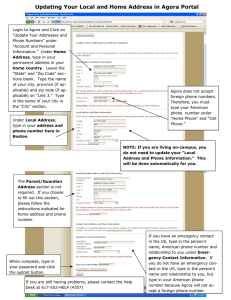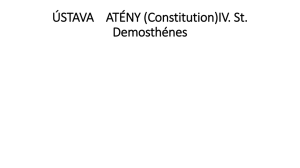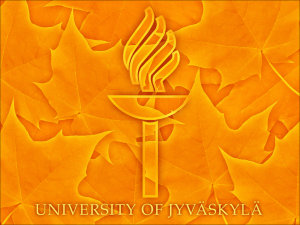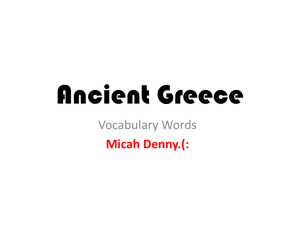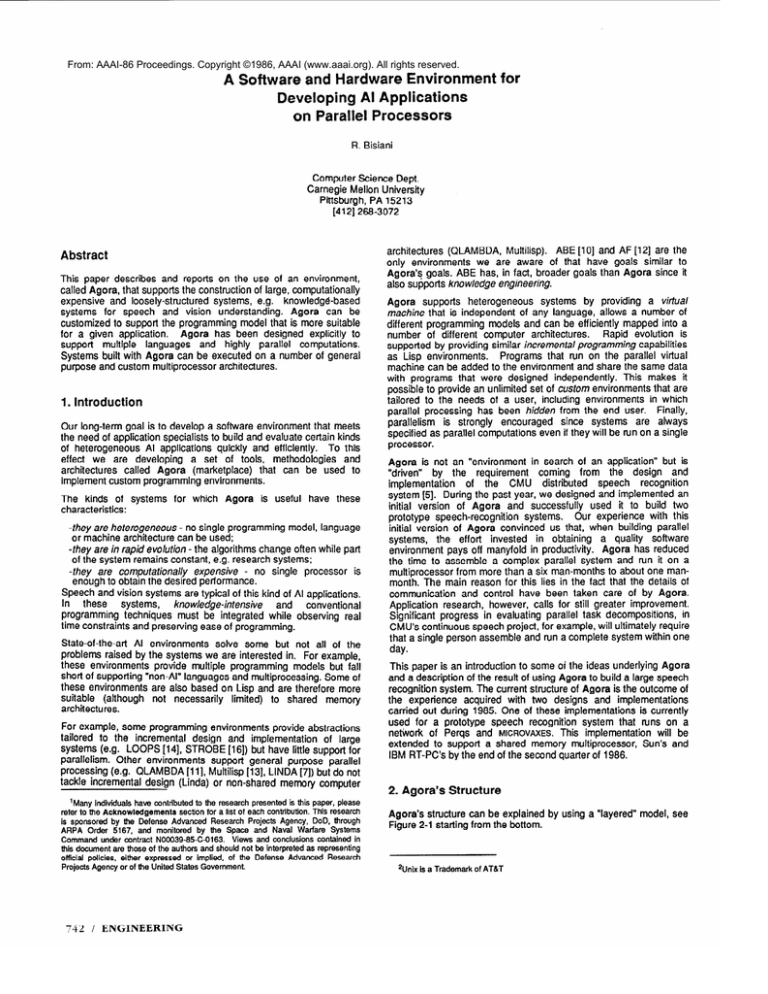
From: AAAI-86 Proceedings. Copyright ©1986, AAAI (www.aaai.org). All rights reserved.
A Software and Hardware Environment for
Developing Al Applications
on Parallel Processors
R. Bisiani
Computer Science Dept.
Carnegie Mellon University
Pittsburgh, PA 15213
(4121 268-3072
Abstract
This paper describes and reports on the use of an environment,
called Agora, that supports the construction of large, computationally
expensive and loosely-structured systems, e.g. knowledge-based
systems for speech and vision understanding.
Agora can be
customized to support the programming model that is more suitable
for a given application.
Agora has been designed explicitly to
support multiple languages
and highly parallel computations.
Systems built with Agora can be executed on a number of general
purpose and custom multiprocessor architectures.
1. Introduction
Our long-term goal is to develop a software environment that meets
the need of application specialists to build and evaluate certain kinds
of heterogeneous Al applications quickly and efficiently.
To this
effect we are developing
a set of tools, methodologies
and
architectures called Agora (marketplace) that can be used to
implement custom programming environments.
The kinds of systems
characteristics:
for which
Agora
is useful
have
these
-they are heterogeneous - no single programming model, language
or machine architecture can be used;
-they are in rapid evolution - the algorithms change often while part
of the system remains constant, e.g. research systems;
-they are computational/y expensive - no single processor is
enough to obtain the desired performance.
Speech and vision systems are typical of this kind of Al applications.
know/edge-intensive and
conventional
In
these
systems,
programming techniques must be integrated while observing real
time constraints and preserving ease of programming.
State-of-the-art
Al environments
solve some but not all of the
problems raised by the systems we are interested in. For example,
these environments provide multiple programming models but fall
short of supporting “non-Al” languages and multiprocessing. Some of
these environments are also based on Lisp and are therefore more
suitable (although not necessarily
limited) to shared memory
architectures.
For example, some programming environments provide abstractions
tailored to the incremental design and implementation of large
systems (e.g. LOOPS [14], STROBE [16]) but have little support for
parallelism. Other environments support general purpose parallel
processing (e.g. QLAMBDA [ll], Multilisp [13], LINDA [7]) but do not
tackle incremental design (Linda) or non-shared memory computer
‘Many individuals have contributed to the research presented is this paper, please
refer to the Acknowledgements section for a list of each contribution. This research
is sponsored by the Defense Advanced Research Projects Agency, DOD, through
ARPA Order 5167, and monitored by the Space and Naval Warfare Systems
Command under contract N00039-65-C-9163. Views and conclusions contained in
this document are those of the authors and should not be interpreted as representing
official policies, either expressed or implied, of the Defense Advanced Research
Projects Agency or of the United States Government.
742
/ ENGINEERING
architectures @LAMBDA, Multilisp). ABE [lo] and AF [12] are the
only environments we are aware of that have goals similar to
Agora’s goals. ABE has, in fact, broader goals than Agora since it
also supports know/edge engineering.
heterogeneous
systems by providing a virtual
of any language, allows a number of
different programming models and can be efficiently mapped into a
Rapid evolution is
number of different computer architectures.
supported by providing similar incremental programming capabilities
Programs that run on the parallel virtual
as Lisp environments.
machine can be added to the environment and share the same data
with programs that were designed independently. This makes it
possible to provide an unlimited set of custom environments that are
tailored to the needs of a user, including environments in which
parallel processing has been hidden from the end user. Finally,
parallelism is strongly encouraged
since systems are always
specified as parallel computations even if they will be run on a single
processor.
Agora
supports
machine that is independent
Agora is not an “environment in search of an application” but is
coming from the design
and
“driven” by the requirement
implementation
of the CMU distributed
speech
recognition
system [5]. During the past year, we designed and implemented an
initial version of Agora and successfully used it to build two
prototype speech-recognition
systems.
Our experience with this
initial version of Agora convinced us that, when building parallel
systems, the effort invested
in obtaining
a quality software
environment pays off manyfold in productivity.
Agora has reduced
the time to assemble a complex parallel system and run it on a
multiprocessor from more than a six man-months to about one manmonth. The main reason for this lies in the fact that the details of
communication and control have been taken care of by Agora.
Application research, however, calls for still greater improvement.
Significant progress in evaluating parallel task decompositions, in
CMU’s continuous speech project, for example, will ultimately require
that a single person assemble and run a complete system within one
day.
This paper is an introduction to some of the ideas underlying Agora
and a description of the result of using Agora to build a large speech
recognition system. The current structure of Agora is the outcome of
the experience acquired with two designs and implementations
carried out during 1985. One of these implementations is currently
used for a prototype speech recognition system that runs on a
netivork of Perqs and MICROVAXES. This implementation will be
extended to support a shared memory multiprocessor, Sun’s and
IBM RT-PC’s by the end of the second quarter of 1986.
2. Agora’s Structure
Agora’s structure can be explained by using a “layered” model, see
Figure 2-l starting from the bottom.
2Unix is a Trademark of AT&T
Interface
I
#
Acoustic
Word
I,
Phonetlc
USi!f
fhnrrlc
TOO18
I
#
Hypothesizer
9
c
Knowledge
Sentence
Source
Parser
Clusters
Coaputatlonal
Frameworks
Frameworks
f Data
Flow
1 Blackboard
--------
.
R7uY
Machine
System
Machines +
Communication
Figure 2-1: Layered
-The first layer is a network of heterogeneous processors: single
processors, shared memory multiprocessors, loosely-connected
multiprocessors and custom hardware accelerators. The Mach
operating
system provides the basic software to execute
computations on all these machines and Agora provides tools to
map Mach abstractions
into real machines.
Mach is a
Unix-compatible2 operating system that runs on multiprocessors,
see [2].
-The Mach layer provides three major abstractions: message
passing, shared memory and threads. Message passing is the
main communication mechanism: all Agora implementations can
run on machines that provide message passing as the only
communication mechanism.
Shared memory (when available in
the underlying computer system) is used to improve performance.
Threads (processes that share the address space with other
processes)
are used to support the fast creation of new
computations (a useful but not always vital characteristic).
-The parallel virtual machine layer represents the “assembly
language level” of Agora.
Computations
are expressed
as
independent procedures that exchange data by using Agora’s
primitives and are activated by means of a pattern matching
mechanism. Computations can be programmed in either C or
Common Lisp. It is in this layer that the most suitable Mach
primitives are selected, the code is compiled and linked, tasks
assigned to machines, etc. Computations expressed at this level
Although systems can be fully
are machine independent.
described at this level, the virtual machine level is best used to
describe frameworks rather than program user computations.
-The framework layer is the level at which most of the application
A framework
is like a specialized
researchers
program.
environment built to interact with the user in familiar terms. The
description,
assembly, debugging and production run of an
application system are all performed through its associated
framework(s). Frameworks, as used in Agora, are very similar to
ABE’s frameworks, see [lo].
Model of Agom
and its Interfaces
First, application engineers program one or more “frameworks” that
implement the programming
environments
that an application
A framework provides all the tools to generate and
requires.
maintain a given kind of program. For example, a framework could
contain virtual machine code to implement data-flow and remoteprocedurecall
communication
mechanisms and a tool to merge
user-supplied code with the existing virtual machine code. Such a
framework could also contain a structured graphical editor that
allows the user to deal with programs in terms of data-flow graphs.
Researchers can then use frameworks to create framework
instantiations, i.e. frameworks that contain user provided code and
data. Components of a framework instantiation can themselves be
instantiations of some other framework.
A framework instantiation
can then be integrated with other framework instantiations to
generate more complex frameworks. In the speech system, for
example, the word hypothesizer is described by using a framework
that embodies the asynchronous control necessary to run the word
hypothesizer in parallel and code to display the data processed: a
user need only be familiar with the algorithms and the language in
which they are written in order to be able to experiment with different
word hypothesization algorithms. A word hypothesizer generated in
this way can be merged with an acoustic-phonetic
framework
instantiation by using, for example, a data-flow framework. Tools
from all the original frameworks are made available in the combined
framework.
We cannot describe frameworks in detail in this paper. Currently, we
have implemented a “Unix-like” framework which lets users build
parallel programs that communicate by using streams. We are
implementing a data-flow framework that will let a user program
through a graphic editor and a number of very specialized
frameworks like the word hypothesizer framework described later.
AI LANGUAGES
AND ARCHITECTURES
/ 743
3. The Agora Virtual Machine
The Agora virtual machine has been designed with two goals in
mind: first, to be able to efficiently execute different programming
models. Second, to avoid restricting the possible implementations to
certain computer
architectures.
Agora
is centered
around
representing data as sets of elements of the same type (elements
can be regarded as variable-size records). Elements are stored in
global structures called c/ioues.
Each clique has a name that
completely identifies if and a type (from a set of globally-defined
types). Agora forces the user to split a computation into separate
called Knowledge
Sources
(KS), that execute
components,
concurrently.
Knowledge Sources exchange data through cliques
and are activated when certain patterns of elements are generated.
Any KS that knows the name of a clique can perform operations on it
since Agora “registers” the name of each clique when it is created.
Since “names” are global, the only requirement for sharing a clique
between KSs is that a clique be first “created” by a KS and then
declared “shared” by another KS. In a speech recognition system,
for example, an element could be a phoneme, word, sentence or
some other meaningful intermediate representation of speech; a
clique could contain all the phonemes generated by a KS and a KS
could be the function that scores phonetic hypotheses.
Element types are described within the KS code by using the syntax
of the language that is used to program the KSs, with some
additional information. The additional information is stripped from the
source code by Agora before the code is handed to the compiler or
interpreter.
This means that users need not learn a different
language. This is in contrast with other language-independent
data
transport mechanisms, like the mechanism described in [4], that use
a separate language to define the data. The type declarations can
contain extra information for scheduling and debugging purposes,
e.g. the expected number of accesses per second, the legal values
that elements can assume, display procedures, etc.
KSs can refer to sets of elements by using capabilities. Capabilities
are manipulated by Agora functions and can be used to “copy” from
a clique into the address space of a KS and viceversa (often no real
copy will be necessary).
There are two “modes” of access:
React-only and Add-element. Elements cannot be modified or
deleted after they are written but Knowledge Sources can signal that
they are not interested anymore in a given Element Clique.
Each KSs contains one or more user functions.
KS functions are
completely independent of the system they are used in and must
only be able to deal with the types of element they use. KSs are
created by calling an Agora primitive, each call to this function can
generate multiple instances of the same KS. When a KS instance is
created, a pattern can be specified: once the pattern is satisfied the
KS function is activated. The pattern is expressed in terms of “arrival
events” (the fact that an element has entered a clique) and in terms
of the values of the data stored in the elements. For example, one
can specify a pattern that is matched every time a new element
enters the clique or that only matches if a field in the element has a
specific value. More than one clique can be mentioned in the same
pattern but no variables are permitted in the pattern (i.e. there is no
Speech
I
binding). It is also possible to specify if an event must be considered
“consumed” by a successful match or if it can be used by other
patterns (this can be very useful to “demultiplex” the contents of a
clique into different KSs or to guarantee mutual exclusion when
needed).
A KS can contain any statement of the language that is being used
and any of the Agora primitives, expressed in a way that is
compatible with the language used. The Agora primitives are similar
to the typical functions that an operating system would provide to
start new processes (create new KS’s in Agora), manipulate files
(create, share and copy cliques) and schedule processes (i.e.
change the amount of computation allocated to a KS).
KS’s are mapped into Mach [2] primitives. In this mapping a KS can
be clustered with other KS’s that can benefit from sharing computer
resources. For examole. a cluster could contain KSs that-access the
same clique or KSs that should be scheduled (i.e. executed)
together.
Although clusters could also be implemented as Mach
tasks, sharing the address space between “random” tasks can be
very dangerous.
Clusters can be implemented (in decreasing order
of efficiency) as multiple processes that share memory or as multiple
processes communicating by messages. Multiple instances of the
same KS have a very effective and simple implementation on the
Mach operating system [2] as a single process (task, in Mach
terminology) in which multiple “threads” of computation implement
the KSs.
Currently, the composition of clusters must be fully specified by the
user. but Aaora maintains information on which KSs are runnable
and on how-much of the cluster computation power each KS should
be-receiving.
The computation power associated with a KS can be
controlled by any KS in a cluster-by using Agora primitives.
In conclusion, the Agora virtual machine provides mechanisms to
statically and dynamically control multiprocessing:
KSs can be
clustered in different ways and executed on different processor
configurations.
Clusters can be used to dynamically control the
Therefore, Agora
provides all the
allocation of processors.
comoonents
necessarv to implement focus-of-attention
policies
within a system, but *the responsibility of designing the ‘control
proceduresremains
with the user.
4. Example of a System Built with Agora
We will illustrate how Agora can be used by describing the design of
the CMU speech recognition system, ANGEL [5]. ANGEL uses more
computation than a single processor could provide (more than 1,000
MIPS), is programmed in two languages (currently, the system
comprises more than 100,000 lines of C and CommonLisp code),
uses many different styles of computation, and is in continuous
evolution since more than 15 researchers are working on it. Figure
4-l shows the top level organization of the system. Arrows indicate
transfer of both data and control. At the top level most of the
components communicate using a data-flow paradigm, with the
exception of a few modules that use a remote-procedure-call)
paradigm. Eventually, a blackboard model will be used at the top
sentence
1
SENTENCE
PROCESSING
,
t.
c
SIGNAL
.
+
F
PARiSER
VERIFIER
Figure 4-l : Structure of the ANGEL Speech Recognilion System:
Top-level and Internal Structure of the
Acoustic-phonetic and Word-hypothesizer Modules
744
! ENGINEERING
I
Type declaration8
level. In Figure 4-1, two components contain a sketch of the structure
For example, the acoustic phonetic
of their subcomponents.
component uses both data-flow and blackboard paradigms.
It is
important to note that Figure 4-1 shows the current structure and that
part of the work being done on the system concerns expanding the
number of modules and evaluating new ways of interconnecting
them.
for cliques
KS setup
Initialization:
Create word and phoneme lattice clique
Instantiate a few copies of KS word-hypothesize
to be activated at the arrival of each new anchor
KS word-hypothesize
Initialization:
Declare the word, phoneme lattice
anchor cliquea as shared
Entry point: if enoughghonemes()
then execute
match0 else instantiate KS wait to be
activated at each new phoneme
and
KS wait
Frameworks
are used to provide each component
with the
environment that is best suited to its development.
At the top level
there is a framework that provides a graphic editor to program dataflow and remote-procedure-call
computations. Each subcomponent
of the top level framework is developed using a different framework.
We will use the word hypothesizer subcomponent as an example.
The word hypothesizer generates word hypotheses by applying a
beam search algorithm at selected times in the utterance. The inputs
of the search are the phonetic hypotheses and the vocabulary. The
times are indicated by a marker, called anchor that is computed
elsewhere. The word hypothesizer must be able to receive anchors
and phonemes in any order and perform a search around each
anchor after having
checked
that all the acoustic-phonetic
hypotheses within delta time units from the anchor are available.
Phonetic hypotheses arrive at unpredictable times and in any order.
The word hypothesizer requires two functions: the matching function
(match()) that hypothesizes words from phonemes and the condition
function (enough-phonemes())
that checks if there are enough
phonemes within a time interval from the anchor. The “editor” of the
word-hypothesizer
framework lets a researcher specify these two
functions and binds them with the virtual machine level description.
This description, that has been programmed by an application
engineer, provides the parallel implementation. The framework also
contains a display function that can be altered by a user.
The stylized code in Figure 4-2 describes the virtual machine level
description used within the word hypothesizer framework. A speech
researcher does not ne,ed to be aware of this description but only of
the external specification
of the two functions match0
and
This description could be written in any
enough-phonemeso.
language supported by Agora (currently C and Common Lisp).
Initialization:
Declare the word, phoneme
anchor cliques as shared
point: if there are enough phonemes
Entry
Figure 4-2:
lattice
and
then match0
The Virtual Machine Level Implementation
the Word Hypothesizer
of
There are three Knowledge Sources: KS setup creates instantiations
of KS word-hypothesize
that are activated when “anchors” arrive.
When any of these KSs receives an “anchor”, it checks if there are
enough phonetic hypotheses and, if so, executes match(). If not
enough hypotheses are available, it creates an instantiation of KS
wait that waits for all the necessary phonemes before executing
match().
The KS word-hypothesize can be compiled into a task if the target
machine does not have shared memory. A parameter of the KS
creation procedure indicates to Agora how many copies of the KS
the framework designer believes can be efficiently used. If the
machine has shared memory, then threads can be used and the
parameter becomes irrelevant since new threads can be generated
without incurring in too much cost. Agora can also be instructed to
generate the wait KSs as threads of the same task. This is possible
if KS wait and the functions it calls do not use any global data.
5. Custom Hardware for the Agora Virtual Machine
In a parallel system, the duration of an atomic computation
(granularity) must be substantially bigger than the overhead required
P- M
I
f-
p --+-
P-M
I
I
I
I
\
P
PPl
I
I
-Y
M
I
Purpose
Sys tern
l
(
General
I
L -----------
J
KS5
Custom
Processor
Figure 5-l : A custom hardware
architecture
for search
AI LANGUAGES
AND ARCHITECTURES
/ 745
o 7 Memory
A 4 Memory
l
bjemory
to start and terminate it. This overhead can be very large when
using (conventional) general purpose architectures.
Agora shares
this characteristic with many other languages and environments. For
example, Multilisp [13] cannot be used to efficiently implement
computations at a very small granularity level unless some special
hardware is provided to speed-up the implementation of futures. The
effect of the overhead can be seen in the performance curves for the
quicksort program presented in [13], Figure 5: the parallel version of
the algorithm requires three times more processing power than the
sequential version in order to run as fast (although it can run faster if
more processing power is available). Therefore, hardware support
2
Blocks
Blocks
Blocks
tailored to the sty/e of parallelism provided 6y a language or an
environment is necessary.
A proposal for an architecture that
supports small granularity in concurrent Smalltalk can be found in [9].
The Agora virtual machine efficiently supports computations with a
granularity larger than 500 ms when implemented on general
purpose machines connected by a local area network. In the case of
shared memory architectures, the limiting factor is the operating
system overhead. Most of the current parallel environments, such as
the Cosmic Cube [15] and Butterfly [3] environments, provide only
minimal operating system functionality: typically, only the basic
functions required to use the hardware.
In these systems,
granularity could be as small as a few hundred microseconds.
Agora supports systems that are too large and complex to be
implemented without a full operating system environment and must
pay the price of operating system overhead.
Therefore, the
minimum granularity of an Agora’s KS on shared memory systems
and Mach is about 1Oms.
There is no single set of hardware which can lower the KS
granularity independently of the computation being performed since
each different style of computation poses different requirements on
the virtual machine primitives. Therefore, our strategy is to develop
architectures tailored to specific computations. So far, we have
designed an architecture that supports computations that can be
pipelined but are data-dependent and cannot be easily vectorized.
For example, pipelines can be generated every time an algorithm
executes a large number of iterations of the same loop.
The
architecture
exploits the fact that data-flow
control can be
implemented
very efficiently
by direct connections
between
processors and the fact that a hardware semaphore associated with
each element of a clique can speed-up concurrent access to
elements. The architecture is custom because a set of KS’s has to
be explicitly decomposed and the architecture configured for that
This process is convenient when an
particular decomposition.
algorithm is reasonably stable.
Figure 5-l shows the structure of the architecture and how it
interfaces with the rest of the system. Each KS is executed in a
Processors communicate through shared
separate processor.
memory as well as through dedicated links. Dedicated links take
care of data-flow while shared memories serve two functions:
input/output and synchronized access to shared data to resolve data-
o 7 Memory
,’
*’
Blocks
746
5-2:
I ENGINEERING
32
Figure 5-3:
728
45
64
91
1000~s MOS Tra nsis tars
Speedup vs. transistors
dependencies.
Each processor contains: a simple hardwired control unit that
executes a fixed program, functional units as reauired bv the KS
function, and register storage. An instruction can specify which data
to read from local storage, what operations to perform on them, and
where to store the result.
A typical instruction can perform an
addition or multiplication or access the shared memory.
The
architecture can be implemented as a fully-dedicated VLSI device or
device set that communicates with the rest of the system through
shared memory.
Therefore, each processor can have different
functional units and be wired directly to the processor(s) that follow it.
A more expensive implementation with off-the-shelf components is
also possible.
We evaluated the architecture by decomposing the match procedure
used in the word hypothesizer described in the previous section.
The match function uses a “best match, beam search” algorithm
though other, more sophisticated search algorithms are already
being planned. The current algorithm requires about 20 to 40 million
instructions per second of speech with a 200-word vocabulary when
executed in C on a VAX-111780, depending on how much knowledge
can be applied to constrain the search. A 5000-word vocabulary will
require 500 to 1000 million instructions per second of speech.
We have simulated the custom architecture instruction-by-instruction
while it executes the beam search algorithm with real data. The
simulation assumed performance figures typical of a CMOS VLSI
design that has not been heavily optimized (and therefore might be
generated semiautomatically using standard cell design techniques).
See [l] for details. The presence of 1, 2, 4, or 7 physical memory
blocks was simulated to evaluate memory access bottlenecks.
Figure 5-2 shows our simulation results as speedup relative to the
performance of a VAX-limo.
,’
Processors
Figure
64
23
Speedup vs. processors
With five KS’s and one physical memory we see a speedup of 170.
This configuration could be implemented on a single custom chip by
using a conservative fabrication technology (memories would still be
implemented with off-the-shelf RAM’S).
With 28 KS’s and seven
memories, we can obtain speedups of three orders of magnitude,
enough to cope with a 5,000 word vocabulary
in real time.
Moreover, each of the 28 processors is much smaller (in terms of
hardware) than the original single processor and all 28 processors
could share the same VLSI device by using the best available
fabrication technology.
This fact is illustrated graphically in Figure
5-3 which plots the speed-up against the transistor count of the
design. I 7e transistor count was obtained by adding the number of
transistors in actual layouts of the various functional units and
registers, and is a crude estimate of the amount of silicon area
required in a VLSI design.
9. Dally, W.J. A VLSI Architecture for Concurrent Data Structures.
Ph.D. Th., California Institute of Technology, March 1986.
6. Conclusions
10. Erman,L. et.al. ABE: Architectural Overview. Proceedings of
the 1985 Distributed Artificial Intelligence Workshop, Sea Ranch,
California.
Agora has a number of characteristics that make it particularly
suitable for the development of complex systems in a multiprocessor
environment. These include:
-the complexity of parallel processing can be hidden by building
“reusable” custom environments that guide a user in describing,
debugging and running an application without getting involved in
parallel programming;
-computations can be expressed in different languages;
-the structure of a system can be modified while the system is
running;
-KSs are activated by patterns computed on the data generated by
other KS’s;
-KSs are described in a way that allows Agora to match the
available architecture and its resources with the requirements of
the computation;
-custom architectures can easily be integrated with components
running on general purpose systems.
11. Gabrie1,R.P. and McCarthy,J. Queue-based multiprocessing
Lisp. Symp. Lisp and Functional Programming, August, 1984.
12. Green,P.E. AF: A Framework for Real-time Distributed
Cooperative Problem Solving. Proceedings of the 1985 Distributed
Artificial Intelligence Workshop, Sea Ranch, California.
13. Halstead, H. “Multilisp: A Language for Concurrent Symbolic
Computation”. ACM Trans. on Programming Languages and
Systems 7, 4 (Octber 1985) 501-538.
14. Bobrow,D.G. and Stefik,M.J. A Virtual Machine for Experiments
in Knowledge Representation. Xerox Palo Alto Research Center,
April, 1982.
15. Seitz, C. L. “The Cosmic Cube”.
1985), 22-33.
Comm. ACM28, 1 (January
16. Smith,R.G. Strobe: Support for Structured Object Knowledge
Representation.
Proceedings of the Eighth International Joint
Conference on Artificial Intelligence, August, 1983.
Acknowledgements
The parallel virtual machine has been designed with Alessandro
Forin [6,8]. Fil Alleva, Rick Lerner and Mike Bauer have participated
in the design and implementation of Agora. The custom architecture
has been designed with Thomas Anantharaman and is described in
detail in [l]. The project has also benefited from the constructive
criticism and support of Raj Reddy, Duane Adams and Renato De
Mori.
References
1. Ananthamaran, T. and Bisiani,R. Custom Search Accelerators for
Speech Recognition. Proceedings of the 13th International
Symposium on Computer Architecture, IEEE, June, 1986.
2. Baron, R., Rashid, R., Siegel, E., Tevanian, A., and Young, M.
“Mach-l : An Operating System Environment for Large Scale
Multiprocessor Applications”. IEEE Software Special Issue (July
1985).
3. anon. The Uniform System Approach to Programming the
Butterfly
Parallel Processor. BBN Laboratories Inc., November
1985.
4. Birrel, A.D. and Nelson,B.J. “Implementing Remote Procedure
Calls”. Trans. Computer Systems 2, 1 (February 1984), 39-59.
5. Adams, D.A., Bisiani, R. The CMU Distributed Speech
Recognition System. Eleventh DARPA Strategic Systems
Symposium, Naval Postgraduate School, Monterey, CA, October,
1985.
6. Bisiani, R. et. al. Building Parallel Speech Recognition Systems
with the Agora Environment. DARPA Strategic Computing Speech
Workshop, Palo Alto, CA, February, 1986.
7. Carriero,N. and Glelemter,D. The S/Net’s Linda Kernel.
Proceedings of the Tenth ACM Symposium on Operating Systems
Principles, December, 1985.
8. Bisiani,R. et.al. Agora, An Environment for Building Problem
Solvers on Distributed Computer Systems. Proceedings of the 1985
Distributed Artificial Intelligence Workshop, Sea Ranch, California.
AI LANGUAGES
AND ARCHITECTURES
I 747

